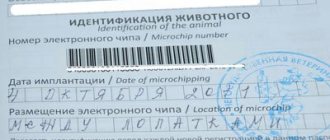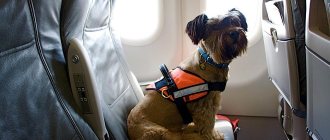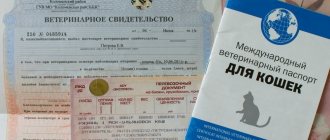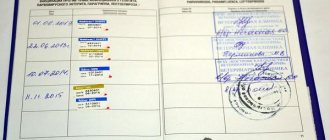Passports are available not only for people, but also for animals. They store basic data about the owner of the animal, the pet itself, information about vaccinations and treatments against parasites.
- Alternative documents
- Dog owner
The editors of Petstory tell you what a veterinary passport for a dog is, how to make it correctly, and what documents to fill out in order to take your pet with you on vacation.
Why do you need a veterinary passport for a dog?
A veterinary passport is needed to transport a pet on planes and trains, to participate in exhibition competitions and for sale. If you are going on vacation without your pet, then without a passport you can only leave it with friends. Official shelters and hotels do not accept animals without passports.
And even if your pet is a homebody, still issue him a document. In the veterinary passport, the veterinarian records all the dates of vaccinations, treatments against parasites and operations undergone. You don’t have to remember when you took this or that vaccination or whether you did it at all. The passport will serve as proof that your pet is vaccinated against rabies. This will help in conflict situations if the dog bites someone. And the most important advantage: if you have a passport, you can always prove that this is your pet. Below we will look at how to fill out a veterinary passport for a dog.
Is it necessary to obtain a passport?
Officially in our country there is no law requiring a passport for a dog. But you will not be able to carry out the official transportation of your pet without this document.
Buying a puppy and list of required documents
Documents that a puppy must have when selling are mandatory:
- A dog's passport is a document confirming its origin. It can also be called a metric or puppy card.
- Veterinary passport.
- If the puppy is more than six months old, it must also have a pedigree.
IMPORTANT! If he is less than six months old, then he cannot have such a document, since the pedigree is drawn up later than this period.
Internal veterinary passport
Let's find out how much it costs to get a dog passport and what information it contains, and also look at a sample dog passport.
A veterinary passport is issued free of charge; the form itself costs from 100 to 300 rubles. The price depends on the appearance and quality of the paper.
The veterinary passport states the following:
- photo of the pet;
- owner details (full name, address, telephone);
- description of the dog (name, breed, date of birth, gender, color, special features);
- vaccinations and parasitic treatments;
- identification number (chip or stamp number);
- additional medical data (diseases, surgeries, dates of estrus and mating, number of puppies born);
- for pedigree dogs, the pedigree number, breeder, brand or chip number are indicated.
In the field about vaccinations and treatments, the veterinarian writes down the date, the name of the drug, and attaches a sticker with the series and number of the drug. Manufacturers include stickers in some tablets. You can stick them on yourself and write down the date when you treated your dog. But to transport your pet you will need a doctor's stamp and signature. In this case, visit a veterinary clinic.
This is what a dog passport might look like. Ozon.ru
Puppy metric
Following the example of human children, a puppy must have a special metric, which, when it reaches a certain age, will be replaced with a full-fledged, “adult” document with official genealogies. The card also indicates all the features of a particular representative of the breed. If fundamental deficiencies are identified, it is necessary to make a note that the individual does not represent breeding value.
The card contains basic information about the puppy:
- breed;
- nickname;
- date of birth;
- floor;
- suit;
- stamp number;
- information about father and mother;
- address and passport information of the puppy's owner.
Attention: in addition to the data, it is important to study stamps and signatures. The card must have a stamp and the full name of the institution where it was received, as well as the data (signature with transcript) of the official.
The top and bottom of a document serve different purposes. What is above the cut line is then transferred to the Russian Cynological Federation. The bottom form remains with the owner. It is important not to lose a copy, because if the official pedigree is lost, it will only be possible to restore it using it.
You will also need it when registering for the exhibition. But only until the dog turns one year and three months old - from that moment on, the “puppy” is invalid. Until this moment, it must be exchanged for a full-fledged pedigree.
No one bothers you to do it later if you failed to attend to the issue in time, but being late is fraught with a fine.
Filling rules
Like any other identification document, the metric must be filled out correctly. All words are written in full, in legible printed letters. It should be remembered that as an RKF employee understands this or that word, he will then write it in the pedigree.
Actually, very little is required from the owner:
- provide your passport information and address;
- remember the index of your place of residence.
The latter must fit in; without the index, they won’t take the “puppy.”
Is it possible to make documents without a puppy card?
Metrica is a guarantee of a smooth receipt of an adult document in the future. Without a card, you will only be able to obtain a registered pedigree. It confirms the fact of belonging to the breed, but you can forget about exhibitions and prizes.
Preparing documents for a pet
Official family trees for four-legged friends are issued by the Russian Cynological Federation (RKF) and the Union of Cynological Organizations of Russia (SCOR).
Other institutions also sometimes issue, as they claim, pedigrees and even official ones. Official - in the sense that they act officially, on behalf of their legal entity. But such a document will have no force. Essentially it's a souvenir.
The documents issued by RKF and SKOR are different and have different validity. This does not mean that one establishment is bad, another is good. The owner must clearly know his goals, what he expects to get from his “bobby” and how to bring him “into the world.”
So, if your plans include competitions and prizes not only within the Russian Federation, but also abroad, and the opportunity to have offspring through any club, then you should definitely go to the RKF. It is their wards that are most valued.
But “bobbies” with SKOR papers will be able to participate in events and reproduce only through this organization.
Attention: owners of the SKOR pedigree can also be recognized in the RKF. The dog must undergo testing in the form of three exhibitions and an assessment by three experts. If they do not notice any flaws, the owner will be given a registered RKF pedigree. With it you can participate in events, compete and even receive prizes - any, except for the Champion title.
Types of Pedigrees and Their Participation in Events
Types of pedigrees Participation in events in the Russian Federation Abroad Obtaining titles Breeding
| RKF | Yes | Yes | Yes | Yes |
| SKOR | Yes | No | Yes, within the framework of SCOR, except for the Champion | Yes, within the framework of SCOR. |
Beware: fakes!
It is best to obtain evidence of the origin of the “bobby” directly from a representative. It is clear that in poultry markets or private individuals there is a high chance of getting defective offspring, even if they all claim to be purebred. It is also necessary to take into account that in Russia absolutely everything is forged, even people’s passports, let alone veterinary and canine papers.
The original document contains all the necessary signatures and seals, is equipped with watermarks, a coat of arms and a hologram. Crude fakes are immediately visible; they have neither watermarks nor holograms. Such sellers rely either on complete laymen or careless owners who will not check anything. But sometimes there are more expensive fakes that even an expert cannot immediately distinguish from real ones.
That is why, if the purity of your pet is not an empty phrase for you, never get involved with private individuals. And it doesn’t hurt to check the metric. It is imperative that the document bears the seal of the institution and the signature of the director.
Where to submit documents?
Representatives of kennel clubs submit documents and paid receipts for obtaining official pedigrees to the RKF Central Office in Moscow. Previously, dog breeders did not have to resort to their mediation. In 2022, it will not be possible to correct the genealogy without representatives of cynological organizations.
Registration of pedigree
The process of obtaining an official pedigree for a pet consists of the following steps:
- go to the administration of the kennel where the puppy was purchased or to the city kennel club;
- find out if they are engaged in registration of pedigrees;
- agree on a time frame (this will take approximately three months);
- leave a puppy card;
- appear at the appointed time for the finished pedigree.
Actually, the adult document looks like an extended version of the “puppy” and contains references to:
- breed;
- name;
- date of birth;
- suits;
- gender;
- owner and breeder;
- stamp number.
To this is added a family tree with clan numbers and titles. On the back there is a protective holographic image in the form of a greyhound's head.
How to read a dog's pedigree
The purity of the breed is judged by three generations - they will be reflected according to FCI standards. Fathers are placed above the records about mothers, grandfathers - above grandmothers. Information about the owner is entered on the left side of the sheet.
It is necessary to carefully check whether all registration numbers are present. Even if there is all the data up to the great-great-grandfather, but one of the members of the dog family does not have a number, the purebred is in question.
What is zero or registered pedigree?
Even the owners of purebred dogs do not always have the opportunity to say exactly who their parents were and how valuable they were in breeding terms. In such cases, a document is drawn up that, apart from the fact that a particular dog belongs to a certain breed, does not guarantee anything. This is the zero pedigree. The dog for which the document is issued is its own ancestor.
Whether this is good or bad depends on the plans and ambitions of the owner. Of course, he indicates that the evaluator is not looking at an ordinary yard “bug,” but a purebred animal. You can get to Russian exhibition events with such paper, but not to international and foreign ones.
But if you approach breeding with all responsibility, then the sons and daughters of the “Bobby” have every chance to realize the high ambitions of the owner and receive high titles, as well as a full-fledged pedigree, listed all over the world.
Why do ordinary dog breeders need genealogy?
A pedigree is required, strictly speaking, only to satisfy the ambitions of the owner and his business if, for example, he has organized a nursery and is breeding dogs. He needs a dog not only to give her unconditional love and receive reciprocal tenderness and affection, but also material benefit, a sense of significance.
International veterinary passport
An international veterinary passport for dogs looks almost the same as a regular one. But all points are additionally written in English.
To travel abroad, your dog must be microchipped. This way you identify the animal and prove that you are its owner. According to international standards, a passport can only be issued for an identified dog.
There are also requirements for rabies vaccination. Your pet must have received it within the last 12 months. If you have not vaccinated your dog, do so at least 20 days before departure. Only after this can you microchip your dog so that the vaccination data is stored in the medical database using the chip number.
For international travel, just a passport is not enough. Carefully study how to properly import a dog into the country you are traveling to. Also call your departure airport to find out their transportation requirements. Some countries may have quarantine requirements for dogs arriving in the country. Sometimes it reaches three weeks. The UK has the strictest conditions.
Also, some countries may require that your animal be sterilized if it is not of breed value.
Fill out all items in clear, understandable handwriting without corrections.
Alternative documents
The Rosselkhoznadzor website provides the following list of documents for traveling with a dog: veterinary passport with data on all vaccinations and studies or veterinary certificate form No. 1 or veterinary certificate of the Customs Union form No. 1 when traveling to Belarus, Kazakhstan, Armenia and Kyrgyzstan.
Apply for a veterinary certificate, Form No. 1, or a veterinary certificate of the Customs Union, Form No. 1, immediately before your trip at state veterinary clinics, as they are valid for 5 days. These documents are issued free of charge.
To receive it you must provide:
- a dog for examination;
- passport with the dates of treatments and vaccinations recorded;
- a note on treatment against echinococcosis (tapeworms);
- the result of a scatological examination for helminth infections;
- requirements of the importing country into which the animal will be imported.
To obtain documents, start preparing your dog in advance. Visit your veterinarian 30 days before departure. If this is a private clinic, then it must have permission to vaccinate animals against rabies. After 30 days, visit the doctor again at a public clinic to receive a certificate or certificate.
To find out the veterinary requirements of the country you need, fill out the online form on the Rosselkhoznadzor website.
You may also need additional documents for travel. In the requirements for traveling to EU countries you can see a European certificate, and for other countries - a certificate of form No. 5a or documents agreed upon between Rosselkhoznadzor and the country of entry. To obtain them, contact the territorial office of Rosselkhoznadzor.
Sample veterinary certificate form No. 1
Sample veterinary certificate of the Customs Union No. 1
Sample certificate form No. 5a
Next, we’ll find out how to make a passport for a dog.
Zero pedigree
A zero certificate is issued to dogs of unknown origin and confirms their belonging to a specific breed.
If the pet does not have any papers confirming its identity, you can try to get them from the federation. This is how a zero pedigree is drawn up, indicating that your pet is the ancestor. Actually, this means that the breeding of purebred animals can begin with this individual. If you don't know how to become the owner of this statement, we will tell you about it further.
Registration process
To become the owner of a pedigree, the owner will first need to obtain a certificate. The certificate is issued based on the assessment of your pet by three federation specialists based on the current standard. If the experts make the appropriate conclusion, you will have a zero pedigree on your hands.
How to get a passport for a dog
Upon official purchase, the breeder must provide you with the dog’s veterinary passport with marks of the first vaccinations. In other cases, you will be issued a passport when visiting a veterinary clinic. You will need to pay for the document itself. Veterinary passport forms are also sold in pet stores. You can come to the veterinary clinic with the form, the doctor will explain how to issue a passport for the dog.
Subscribe to the newsletter and receive a discount from the Pet store
Thanks for subscribing!
An email with a promotional code has already been sent to your email.
Payment for carriage
Most likely, the animal and cage will need to be paid for as additional baggage. This is true even if you are transporting a small carrier with a cat, and besides it you only have a light bag, i.e. The dimensions and weight included in the ticket price are not exceeded. The fact of payment is confirmed by a special baggage ticket, which is issued at regular ticket offices. The ability to purchase such travel documents is also available on most ticket ordering sites.
How to correctly fill out a dog’s veterinary passport - sample
Now we will look at how to correctly fill out a dog passport
To travel abroad, all information must be entered or duplicated in English, the name of the animal must be indicated in Latin letters. There should be no torn pages in the passport. Fill out your passport in block letters using a black or blue pen.
You can enter some of the information yourself; the vaccination notes and identification of the animal are filled out by the veterinarian.
The photographs below show a sample of filling out a dog passport.
Dog owner
Indicate the name of the dog owner and his address.
Please note that there are several fields available for completion. A dog can have several co-owners. If one of your family members takes the dog on a trip, he must be included in the veterinary passport.
Description of the dog
Indicate the dog's name, date of birth, breed. Write the breed only if you know it for sure. If your dog is not purebred, then you need to write “mixed breed”. Next, indicate the gender: female or male. Next, indicate the color of the dog. Write down the exact color if you know. If not, describe it yourself: black, black and white, red, etc.
Deworming and treatment against ectoparasites
Fill out this item if you yourself give your dog pills for worms and ticks. Indicate the date and name of the medications. If the treatment is carried out by a doctor, he will enter all the information himself.
Vaccination information
The items “Vaccination against rabies” and “Other vaccinations” will be filled out by a veterinarian.
Notice how the doctor fills out the vaccination sections. He must indicate the date, attach a sticker with the name of the drug, sign and seal.
Below is a sample of how to fill out these pages in a veterinary passport for a dog.
Pedigree RKF
As for the pedigree of the RKF, this paper is one of the most important for a pet. Especially if your pet is purebred and you intend to participate in various events with it. In particular, export abroad or if your dog will participate in breeding work. This paper confirms that your dog is truly purebred, since it contains all the information about the animal’s ancestors. That is, in fact, the RKF pedigree is a documentary confirmation of information regarding the origin of the dog.
The RKF pedigree consists of several parts:
- One of them notes the color of the dog, its variety, type of fur, name, gender and brand. The date of birth of the pet will also be noted here.
- In addition, the RKF pedigree also contains information about the dog breeder. All basic information about a person, in particular, his data (last name, first name, patronymic), contact phone number and address. The RKF also requires that the pedigree indicate the name of the dog, that is, the father of your pet.
- Another column indicates the name of the mother who gave birth to the dog. If there is no information in the RKF pedigree, it may be rejected and will be considered invalid. If your dog's ancestors had any titles or awards received at shows, then this should also be noted.
Pedigree RKF
In addition to the father and mother, the pedigree indicates relatives up to the 3rd or 4th generation (different pedigrees for different numbers of ancestors).
Registration process
As for how to make a pedigree for a dog, this paper is issued by representatives of the RKF. To receive it, the dog breeder must provide a metric where all the necessary data will be marked. Even if you do not plan to export the animal abroad, the information must still be indicated. To obtain the RKF pedigree, the dog does not even have to be shown to specialists. To do this, it is enough to purchase a purebred pet that already has a pedigree.
Of course, the honesty of the breeder is an important factor - if you fall for a deceiver, then the passport may be fake. Without it, you will not be able to travel abroad with your dog or obtain other documents. If you do not want to get into this situation, we recommend working only with trusted breeding organizations. At worst, before purchasing, if you wish, you can check all the entered information.
Having in hand a metric that will be approved by RKF representatives, the owner of the animal can change it to the RKF pedigree. Without a RKF pedigree, the dog will not be able to take part in exhibitions or breeding work. RKF specialists can always check whether the metric is filled out correctly, as well as any information about the animal. Only after the RKF representative decides to check the paper and everything is filled out correctly, you will be able to receive the pedigree in your hands (video author - GuberniaTV).
What to do if you have lost your veterinary passport
The most important thing in a veterinary passport is information about the latest vaccinations for the year. If you haven’t done them for your pet, then you can simply get a new veterinary passport when you visit the veterinarian. To restore complete information, contact the veterinary clinic where your pet is usually seen. Data on rabies vaccinations and required vaccinations due to outbreaks of infectious diseases are stored in the general register for at least 5 years. And once a quarter, clinics submit data to the State Veterinary Supervision Authority, where they are stored for at least 10 years.
If your dog is microchipped, it will be easier to recover the data. It can be extracted from the EDB - a single database. Make sure your doctor enters your pet's chip identification number into the EDB. On subsequent visits to the veterinarian, find out whether he has entered information about the manipulations performed.
Marks in the veterinary passport on vaccination against rabies and other vaccinations
Special attention is paid to the vaccination marks in the veterinary passport both when moving an animal within the Russian Federation or the Customs Union, and when exporting it to EU countries. Some countries also pay attention to what exactly the animal was vaccinated with: the vaccine must be certified within the country. In addition, at the time of vaccination the pet must already be microchipped.
Be especially careful to ensure that each vaccination record is accompanied by a vaccine sticker with its number and other data. In many countries, an entry without this will be considered invalid, even if the doctor’s signature and the clinic’s seal are present.











